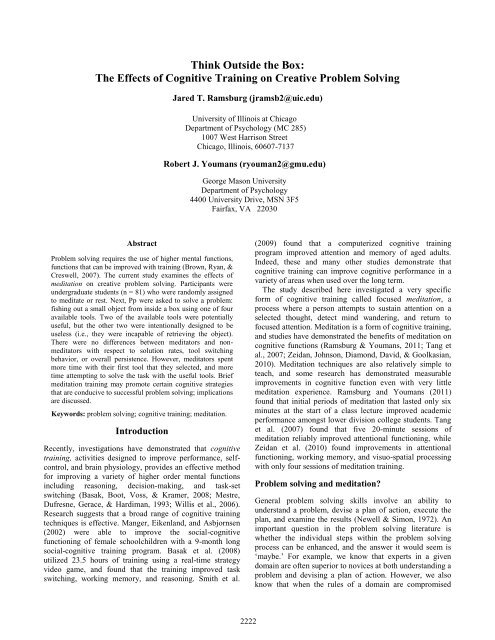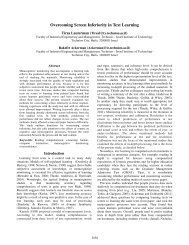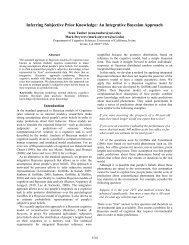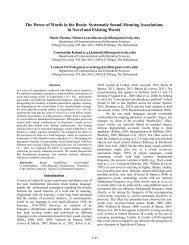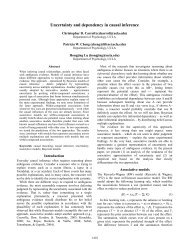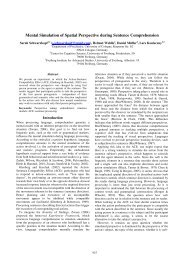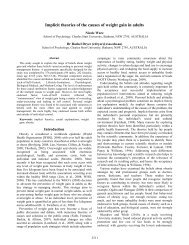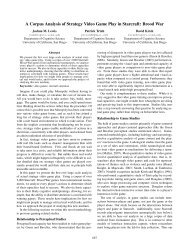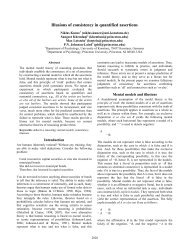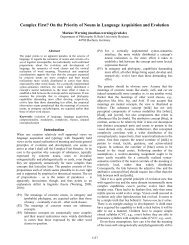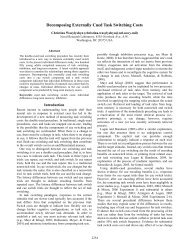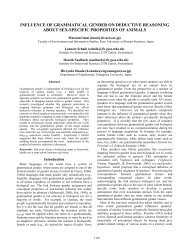Think Outside the Box: The Effects of Cognitive Training on Creative ...
Think Outside the Box: The Effects of Cognitive Training on Creative ...
Think Outside the Box: The Effects of Cognitive Training on Creative ...
You also want an ePaper? Increase the reach of your titles
YUMPU automatically turns print PDFs into web optimized ePapers that Google loves.
<str<strong>on</strong>g>Think</str<strong>on</strong>g> <str<strong>on</strong>g>Outside</str<strong>on</strong>g> <str<strong>on</strong>g>the</str<strong>on</strong>g> <str<strong>on</strong>g>Box</str<strong>on</strong>g>:<br />
<str<strong>on</strong>g>The</str<strong>on</strong>g> <str<strong>on</strong>g>Effects</str<strong>on</strong>g> <str<strong>on</strong>g>of</str<strong>on</strong>g> <str<strong>on</strong>g>Cognitive</str<strong>on</strong>g> <str<strong>on</strong>g>Training</str<strong>on</strong>g> <strong>on</strong> <strong>Creative</strong> Problem Solving<br />
Abstract<br />
Problem solving requires <str<strong>on</strong>g>the</str<strong>on</strong>g> use <str<strong>on</strong>g>of</str<strong>on</strong>g> higher mental functi<strong>on</strong>s,<br />
functi<strong>on</strong>s that can be improved with training (Brown, Ryan, &<br />
Creswell, 2007). <str<strong>on</strong>g>The</str<strong>on</strong>g> current study examines <str<strong>on</strong>g>the</str<strong>on</strong>g> effects <str<strong>on</strong>g>of</str<strong>on</strong>g><br />
meditati<strong>on</strong> <strong>on</strong> creative problem solving. Participants were<br />
undergraduate students (n = 81) who were randomly assigned<br />
to meditate or rest. Next, Pp were asked to solve a problem:<br />
fishing out a small object from inside a box using <strong>on</strong>e <str<strong>on</strong>g>of</str<strong>on</strong>g> four<br />
available tools. Two <str<strong>on</strong>g>of</str<strong>on</strong>g> <str<strong>on</strong>g>the</str<strong>on</strong>g> available tools were potentially<br />
useful, but <str<strong>on</strong>g>the</str<strong>on</strong>g> o<str<strong>on</strong>g>the</str<strong>on</strong>g>r two were intenti<strong>on</strong>ally designed to be<br />
useless (i.e., <str<strong>on</strong>g>the</str<strong>on</strong>g>y were incapable <str<strong>on</strong>g>of</str<strong>on</strong>g> retrieving <str<strong>on</strong>g>the</str<strong>on</strong>g> object).<br />
<str<strong>on</strong>g>The</str<strong>on</strong>g>re were no differences between meditators and n<strong>on</strong>meditators<br />
with respect to soluti<strong>on</strong> rates, tool switching<br />
behavior, or overall persistence. However, meditators spent<br />
more time with <str<strong>on</strong>g>the</str<strong>on</strong>g>ir first tool that <str<strong>on</strong>g>the</str<strong>on</strong>g>y selected, and more<br />
time attempting to solve <str<strong>on</strong>g>the</str<strong>on</strong>g> task with <str<strong>on</strong>g>the</str<strong>on</strong>g> useful tools. Brief<br />
meditati<strong>on</strong> training may promote certain cognitive strategies<br />
that are c<strong>on</strong>ducive to successful problem solving; implicati<strong>on</strong>s<br />
are discussed.<br />
Keywords: problem solving; cognitive training; meditati<strong>on</strong>.<br />
Introducti<strong>on</strong><br />
Recently, investigati<strong>on</strong>s have dem<strong>on</strong>strated that cognitive<br />
training, activities designed to improve performance, selfc<strong>on</strong>trol,<br />
and brain physiology, provides an effective method<br />
for improving a variety <str<strong>on</strong>g>of</str<strong>on</strong>g> higher order mental functi<strong>on</strong>s<br />
including reas<strong>on</strong>ing, decisi<strong>on</strong>-making, and task-set<br />
switching (Basak, Boot, Voss, & Kramer, 2008; Mestre,<br />
Dufresne, Gerace, & Hardiman, 1993; Willis et al., 2006).<br />
Research suggests that a broad range <str<strong>on</strong>g>of</str<strong>on</strong>g> cognitive training<br />
techniques is effective. Manger, Eikenland, and Asbjornsen<br />
(2002) were able to improve <str<strong>on</strong>g>the</str<strong>on</strong>g> social-cognitive<br />
functi<strong>on</strong>ing <str<strong>on</strong>g>of</str<strong>on</strong>g> female schoolchildren with a 9-m<strong>on</strong>th l<strong>on</strong>g<br />
social-cognitive training program. Basak et al. (2008)<br />
utilized 23.5 hours <str<strong>on</strong>g>of</str<strong>on</strong>g> training using a real-time strategy<br />
video game, and found that <str<strong>on</strong>g>the</str<strong>on</strong>g> training improved task<br />
switching, working memory, and reas<strong>on</strong>ing. Smith et al.<br />
Jared T. Ramsburg (jramsb2@uic.edu)<br />
University <str<strong>on</strong>g>of</str<strong>on</strong>g> Illinois at Chicago<br />
Department <str<strong>on</strong>g>of</str<strong>on</strong>g> Psychology (MC 285)<br />
1007 West Harris<strong>on</strong> Street<br />
Chicago, Illinois, 60607-7137<br />
Robert J. Youmans (ryouman2@gmu.edu)<br />
George Mas<strong>on</strong> University<br />
Department <str<strong>on</strong>g>of</str<strong>on</strong>g> Psychology<br />
4400 University Drive, MSN 3F5<br />
Fairfax, VA 22030<br />
2222<br />
(2009) found that a computerized cognitive training<br />
program improved attenti<strong>on</strong> and memory <str<strong>on</strong>g>of</str<strong>on</strong>g> aged adults.<br />
Indeed, <str<strong>on</strong>g>the</str<strong>on</strong>g>se and many o<str<strong>on</strong>g>the</str<strong>on</strong>g>r studies dem<strong>on</strong>strate that<br />
cognitive training can improve cognitive performance in a<br />
variety <str<strong>on</strong>g>of</str<strong>on</strong>g> areas when used over <str<strong>on</strong>g>the</str<strong>on</strong>g> l<strong>on</strong>g term.<br />
<str<strong>on</strong>g>The</str<strong>on</strong>g> study described here investigated a very specific<br />
form <str<strong>on</strong>g>of</str<strong>on</strong>g> cognitive training called focused meditati<strong>on</strong>, a<br />
process where a pers<strong>on</strong> attempts to sustain attenti<strong>on</strong> <strong>on</strong> a<br />
selected thought, detect mind wandering, and return to<br />
focused attenti<strong>on</strong>. Meditati<strong>on</strong> is a form <str<strong>on</strong>g>of</str<strong>on</strong>g> cognitive training,<br />
and studies have dem<strong>on</strong>strated <str<strong>on</strong>g>the</str<strong>on</strong>g> benefits <str<strong>on</strong>g>of</str<strong>on</strong>g> meditati<strong>on</strong> <strong>on</strong><br />
cognitive functi<strong>on</strong>s (Ramsburg & Youmans, 2011; Tang et<br />
al., 2007; Zeidan, Johns<strong>on</strong>, Diam<strong>on</strong>d, David, & Goolkasian,<br />
2010). Meditati<strong>on</strong> techniques are also relatively simple to<br />
teach, and some research has dem<strong>on</strong>strated measurable<br />
improvements in cognitive functi<strong>on</strong> even with very little<br />
meditati<strong>on</strong> experience. Ramsburg and Youmans (2011)<br />
found that initial periods <str<strong>on</strong>g>of</str<strong>on</strong>g> meditati<strong>on</strong> that lasted <strong>on</strong>ly six<br />
minutes at <str<strong>on</strong>g>the</str<strong>on</strong>g> start <str<strong>on</strong>g>of</str<strong>on</strong>g> a class lecture improved academic<br />
performance am<strong>on</strong>gst lower divisi<strong>on</strong> college students. Tang<br />
et al. (2007) found that five 20-minute sessi<strong>on</strong>s <str<strong>on</strong>g>of</str<strong>on</strong>g><br />
meditati<strong>on</strong> reliably improved attenti<strong>on</strong>al functi<strong>on</strong>ing, while<br />
Zeidan et al. (2010) found improvements in attenti<strong>on</strong>al<br />
functi<strong>on</strong>ing, working memory, and visuo-spatial processing<br />
with <strong>on</strong>ly four sessi<strong>on</strong>s <str<strong>on</strong>g>of</str<strong>on</strong>g> meditati<strong>on</strong> training.<br />
Problem solving and meditati<strong>on</strong>?<br />
General problem solving skills involve an ability to<br />
understand a problem, devise a plan <str<strong>on</strong>g>of</str<strong>on</strong>g> acti<strong>on</strong>, execute <str<strong>on</strong>g>the</str<strong>on</strong>g><br />
plan, and examine <str<strong>on</strong>g>the</str<strong>on</strong>g> results (Newell & Sim<strong>on</strong>, 1972). An<br />
important questi<strong>on</strong> in <str<strong>on</strong>g>the</str<strong>on</strong>g> problem solving literature is<br />
whe<str<strong>on</strong>g>the</str<strong>on</strong>g>r <str<strong>on</strong>g>the</str<strong>on</strong>g> individual steps within <str<strong>on</strong>g>the</str<strong>on</strong>g> problem solving<br />
process can be enhanced, and <str<strong>on</strong>g>the</str<strong>on</strong>g> answer it would seem is<br />
‘maybe.’ For example, we know that experts in a given<br />
domain are <str<strong>on</strong>g>of</str<strong>on</strong>g>ten superior to novices at both understanding a<br />
problem and devising a plan <str<strong>on</strong>g>of</str<strong>on</strong>g> acti<strong>on</strong>. However, we also<br />
know that when <str<strong>on</strong>g>the</str<strong>on</strong>g> rules <str<strong>on</strong>g>of</str<strong>on</strong>g> a domain are compromised
(e.g., impossible chess positi<strong>on</strong>s) or when an expert in <strong>on</strong>e<br />
domain is asked to perform a task in a different domain, socalled<br />
‘experts’ <str<strong>on</strong>g>of</str<strong>on</strong>g>ten fail to transfer <str<strong>on</strong>g>the</str<strong>on</strong>g>ir expertise between<br />
<str<strong>on</strong>g>the</str<strong>on</strong>g> two domains (Ohlss<strong>on</strong>, 2011).<br />
Although meditati<strong>on</strong> has been shown to improve a variety<br />
<str<strong>on</strong>g>of</str<strong>on</strong>g> cognitive functi<strong>on</strong>s, relatively few studies have directly<br />
examined <str<strong>on</strong>g>the</str<strong>on</strong>g> influences <str<strong>on</strong>g>of</str<strong>on</strong>g> meditati<strong>on</strong> training <strong>on</strong> problem<br />
solving (Dillbeck, 1982; Kindler, 1979; Raingruber &<br />
Robins<strong>on</strong>, 2007). Kindler (1979) found that group problem<br />
solving could be improved with meditati<strong>on</strong> training,<br />
specifically, improving speed to soluti<strong>on</strong> and promoting<br />
effective teamwork. Raingruber and Robins<strong>on</strong> (2007) found<br />
using a qualitative approach that nurses engaged in<br />
meditati<strong>on</strong> training reported improvements in <str<strong>on</strong>g>the</str<strong>on</strong>g>ir problem<br />
solving abilities, attenti<strong>on</strong>, and calm. <str<strong>on</strong>g>The</str<strong>on</strong>g>se findings suggest<br />
that meditati<strong>on</strong> might be an effective method for improving<br />
problem solving, but more study is clearly required.<br />
If meditati<strong>on</strong> were to enhance problem solving, we<br />
hypo<str<strong>on</strong>g>the</str<strong>on</strong>g>size here that its influence might be most<br />
pr<strong>on</strong>ounced <strong>on</strong> <str<strong>on</strong>g>the</str<strong>on</strong>g> actual executi<strong>on</strong> <str<strong>on</strong>g>of</str<strong>on</strong>g> any given problem<br />
solving strategy. Whereas expertise is likely to act <strong>on</strong> <str<strong>on</strong>g>the</str<strong>on</strong>g><br />
stages <str<strong>on</strong>g>of</str<strong>on</strong>g> problem solving that require accurate problem<br />
framing (i.e., understanding problems and devising<br />
soluti<strong>on</strong>s), meditati<strong>on</strong> and o<str<strong>on</strong>g>the</str<strong>on</strong>g>r types <str<strong>on</strong>g>of</str<strong>on</strong>g> cognitive training<br />
might have positive effects <strong>on</strong> some <str<strong>on</strong>g>of</str<strong>on</strong>g> <str<strong>on</strong>g>the</str<strong>on</strong>g> key cognitive<br />
processes utilized while trying to execute a plan <str<strong>on</strong>g>of</str<strong>on</strong>g> acti<strong>on</strong><br />
during problem solving (Lutz et al., 2009; Mayer, 1992;<br />
Tang et al., 2007; Zeidan et al., 2010). Ly and Spezio (2009)<br />
found via fMRI that meditati<strong>on</strong> could improve decisi<strong>on</strong>making<br />
by influencing neural circuits in an enduring manner<br />
for recruitment during <str<strong>on</strong>g>the</str<strong>on</strong>g> self-regulati<strong>on</strong> <str<strong>on</strong>g>of</str<strong>on</strong>g> social cognitive<br />
processes. O<str<strong>on</strong>g>the</str<strong>on</strong>g>r studies have dem<strong>on</strong>strated that mediators<br />
appear to display more c<strong>on</strong>scientious decisi<strong>on</strong> making<br />
(Kirk, Downar, & Read M<strong>on</strong>tague, 2011), or cognitive<br />
flexibility, a mental ability important in problem solving<br />
(Dillbeck, 1982; So & Orme-Johns<strong>on</strong>, 2001). <str<strong>on</strong>g>The</str<strong>on</strong>g>se and<br />
o<str<strong>on</strong>g>the</str<strong>on</strong>g>r studies suggest a link between meditati<strong>on</strong> and o<str<strong>on</strong>g>the</str<strong>on</strong>g>r<br />
forms <str<strong>on</strong>g>of</str<strong>on</strong>g> cognitive training, and <str<strong>on</strong>g>the</str<strong>on</strong>g> cognitive functi<strong>on</strong>s used<br />
during problem solving itself.<br />
In this study, we examined <str<strong>on</strong>g>the</str<strong>on</strong>g> effect <str<strong>on</strong>g>of</str<strong>on</strong>g> meditati<strong>on</strong>, a<br />
form <str<strong>on</strong>g>of</str<strong>on</strong>g> cognitive training, <strong>on</strong> a real-world, creative<br />
problem-solving task. Participants received ei<str<strong>on</strong>g>the</str<strong>on</strong>g>r brief<br />
meditati<strong>on</strong> training or rest, and <str<strong>on</strong>g>the</str<strong>on</strong>g>n attempted to solve a<br />
novel creative problem. Although past studies have shown<br />
<strong>on</strong>ly moderate training benefits <strong>on</strong> problem solving tasks<br />
(e.g., Kershaw & Ohlss<strong>on</strong>, 2004), we hypo<str<strong>on</strong>g>the</str<strong>on</strong>g>sized that<br />
meditati<strong>on</strong>, which has been shown to improve cognitive<br />
functi<strong>on</strong>ing (So & Orme-Johns<strong>on</strong>, 2001; Tang et al., 2007)<br />
may be an effective method for promoting creative problem<br />
solving in general.<br />
Participants<br />
Method<br />
Eighty-<strong>on</strong>e California State University, Northridge students<br />
participated for course credit. Participants had an average<br />
age <str<strong>on</strong>g>of</str<strong>on</strong>g> 18.73 with a standard deviati<strong>on</strong> <str<strong>on</strong>g>of</str<strong>on</strong>g> 1.32. <str<strong>on</strong>g>The</str<strong>on</strong>g>re were<br />
2223<br />
61 females and 20 males. Participants identified <str<strong>on</strong>g>the</str<strong>on</strong>g>mselves<br />
as Latino/Hispanic (45.7%), Black/African-American<br />
(19.8%), Caucasian (19.8%), more than <strong>on</strong>e race/o<str<strong>on</strong>g>the</str<strong>on</strong>g>r<br />
(6.2%), Asian or Pacific Islander (4.9%), and Middle<br />
Eastern (2.5%).<br />
Problem-solving task<br />
<str<strong>on</strong>g>The</str<strong>on</strong>g> researchers developed a novel creative problem-solving<br />
task. <str<strong>on</strong>g>The</str<strong>on</strong>g> task was a physical problem that required <str<strong>on</strong>g>the</str<strong>on</strong>g> use<br />
<str<strong>on</strong>g>of</str<strong>on</strong>g> unique experimenter designed tools to solve <str<strong>on</strong>g>the</str<strong>on</strong>g> task.<br />
Specifically, <str<strong>on</strong>g>the</str<strong>on</strong>g> objective was to get a bolt out <str<strong>on</strong>g>of</str<strong>on</strong>g> a box and<br />
across a red line (six and a half feet away from <str<strong>on</strong>g>the</str<strong>on</strong>g> box)<br />
using <str<strong>on</strong>g>the</str<strong>on</strong>g> four experimenter designed tools.<br />
Materials<br />
<str<strong>on</strong>g>Box</str<strong>on</strong>g> and Bolt. <str<strong>on</strong>g>The</str<strong>on</strong>g> box (see Figure 1) was made using 5<br />
½ by ¾ inch wood, a 16 inch in length, 3 inch high, and<br />
1/16 inch thick piece <str<strong>on</strong>g>of</str<strong>on</strong>g> clear flexible plastic, and a 23 by 18<br />
inch plywood base. <str<strong>on</strong>g>The</str<strong>on</strong>g> back face <str<strong>on</strong>g>of</str<strong>on</strong>g> <str<strong>on</strong>g>the</str<strong>on</strong>g> box measured 17 ¼<br />
inches. <str<strong>on</strong>g>The</str<strong>on</strong>g> two wooded sides measured 23 inches in length.<br />
<str<strong>on</strong>g>The</str<strong>on</strong>g> clear plastic fr<strong>on</strong>t piece with red tape lining its top was<br />
3 inches high and was glued into place 16 ½ inches from <str<strong>on</strong>g>the</str<strong>on</strong>g><br />
back side <str<strong>on</strong>g>of</str<strong>on</strong>g> <str<strong>on</strong>g>the</str<strong>on</strong>g> box, which left two 6 ¾ inch in length n<strong>on</strong><br />
encased walls. A modified 5/8 th inch lag bolt was <str<strong>on</strong>g>the</str<strong>on</strong>g> target<br />
that participants were trying to retrieve. <str<strong>on</strong>g>The</str<strong>on</strong>g> bolt was placed<br />
standing upright inside <str<strong>on</strong>g>the</str<strong>on</strong>g> box at <str<strong>on</strong>g>the</str<strong>on</strong>g> beginning <str<strong>on</strong>g>of</str<strong>on</strong>g> each<br />
experiment. <str<strong>on</strong>g>The</str<strong>on</strong>g> bolt was 3 inches in length had seven 1 ¾<br />
inch washers secured by two 5/8 th inch nuts.<br />
Figure 1. <str<strong>on</strong>g>The</str<strong>on</strong>g> <str<strong>on</strong>g>Box</str<strong>on</strong>g> with <str<strong>on</strong>g>the</str<strong>on</strong>g> Bolt in <str<strong>on</strong>g>the</str<strong>on</strong>g> Starting Positi<strong>on</strong>.<br />
Claw. <str<strong>on</strong>g>The</str<strong>on</strong>g> claw was <strong>on</strong>e <str<strong>on</strong>g>of</str<strong>on</strong>g> <str<strong>on</strong>g>the</str<strong>on</strong>g> two tools that were<br />
capable <str<strong>on</strong>g>of</str<strong>on</strong>g> retrieving <str<strong>on</strong>g>the</str<strong>on</strong>g> bolt (see Figure 3). It c<strong>on</strong>sisted <str<strong>on</strong>g>of</str<strong>on</strong>g><br />
a modified metal grabber extensi<strong>on</strong> tool. <str<strong>on</strong>g>The</str<strong>on</strong>g> claw was 53 ¾<br />
inches l<strong>on</strong>g. A piece <str<strong>on</strong>g>of</str<strong>on</strong>g> thin rope c<strong>on</strong>nected <str<strong>on</strong>g>the</str<strong>on</strong>g> “trigger” at<br />
<str<strong>on</strong>g>the</str<strong>on</strong>g> handle, and <str<strong>on</strong>g>the</str<strong>on</strong>g> grasping claw. <str<strong>on</strong>g>The</str<strong>on</strong>g> grasp <str<strong>on</strong>g>of</str<strong>on</strong>g> <str<strong>on</strong>g>the</str<strong>on</strong>g> claw<br />
was weak, making <str<strong>on</strong>g>the</str<strong>on</strong>g> straightforward method <str<strong>on</strong>g>of</str<strong>on</strong>g> using <str<strong>on</strong>g>the</str<strong>on</strong>g><br />
tool to retrieve <str<strong>on</strong>g>the</str<strong>on</strong>g> bolt difficult, but not impossible.<br />
Figure 2. <str<strong>on</strong>g>The</str<strong>on</strong>g> Claw.
Magnet. <str<strong>on</strong>g>The</str<strong>on</strong>g> magnet was <str<strong>on</strong>g>the</str<strong>on</strong>g> sec<strong>on</strong>d tool that was<br />
capable <str<strong>on</strong>g>of</str<strong>on</strong>g> retrieving <str<strong>on</strong>g>the</str<strong>on</strong>g> bolt (see Figure 4). It c<strong>on</strong>sisted <str<strong>on</strong>g>of</str<strong>on</strong>g> a<br />
35 ½ inch l<strong>on</strong>g PVC pipe that was 1 ¼ inches in diameter<br />
that was c<strong>on</strong>nected to ano<str<strong>on</strong>g>the</str<strong>on</strong>g>r PVC pipe that was 12 inches<br />
in length. <str<strong>on</strong>g>The</str<strong>on</strong>g> two pieces <str<strong>on</strong>g>of</str<strong>on</strong>g> PVC pipe were joined by a<br />
spring that was 5/6 inch diameter and 8 inches l<strong>on</strong>g. A rope<br />
was laced through <str<strong>on</strong>g>the</str<strong>on</strong>g> top that hung 34 ½ inches. At <str<strong>on</strong>g>the</str<strong>on</strong>g> end<br />
<str<strong>on</strong>g>of</str<strong>on</strong>g> <str<strong>on</strong>g>the</str<strong>on</strong>g> rope was a 2-inch diameter magnet. <str<strong>on</strong>g>The</str<strong>on</strong>g> magnet was<br />
too weak to lift <str<strong>on</strong>g>the</str<strong>on</strong>g> bolt outright, but it could be used to drag<br />
<str<strong>on</strong>g>the</str<strong>on</strong>g> bolt. Using <str<strong>on</strong>g>the</str<strong>on</strong>g> magnet and loose string in combinati<strong>on</strong>,<br />
it was difficult, but possible, to retrieve <str<strong>on</strong>g>the</str<strong>on</strong>g> bolt.<br />
Figure 4. <str<strong>on</strong>g>The</str<strong>on</strong>g> Magnet.<br />
Spatula. <str<strong>on</strong>g>The</str<strong>on</strong>g> spatula was <strong>on</strong>e <str<strong>on</strong>g>of</str<strong>on</strong>g> two tools that were not<br />
capable <str<strong>on</strong>g>of</str<strong>on</strong>g> retrieving <str<strong>on</strong>g>the</str<strong>on</strong>g> bolt. It c<strong>on</strong>sisted <str<strong>on</strong>g>of</str<strong>on</strong>g> a 49-inch l<strong>on</strong>g<br />
piece <str<strong>on</strong>g>of</str<strong>on</strong>g> flexible PVC pipe that was 5/8 inches in diameter<br />
had a plastic paint scrapper fastened to <strong>on</strong>e end by three<br />
screws (see Figure 5). <str<strong>on</strong>g>The</str<strong>on</strong>g> o<str<strong>on</strong>g>the</str<strong>on</strong>g>r end had a less flexible PVC<br />
pipe that was 11 ½ inches l<strong>on</strong>g and 5/8 inch in diameter<br />
attached. At each <str<strong>on</strong>g>of</str<strong>on</strong>g> <str<strong>on</strong>g>the</str<strong>on</strong>g>se ends was a 23 ½ inch l<strong>on</strong>g PVC<br />
pipe that would serve as <str<strong>on</strong>g>the</str<strong>on</strong>g> handles for <str<strong>on</strong>g>the</str<strong>on</strong>g> tool. <str<strong>on</strong>g>The</str<strong>on</strong>g><br />
flexibility <str<strong>on</strong>g>of</str<strong>on</strong>g> <str<strong>on</strong>g>the</str<strong>on</strong>g> tool made <str<strong>on</strong>g>the</str<strong>on</strong>g> tool useless.<br />
Figure 5. <str<strong>on</strong>g>The</str<strong>on</strong>g> Spatula.<br />
Ring. <str<strong>on</strong>g>The</str<strong>on</strong>g> ring was <str<strong>on</strong>g>the</str<strong>on</strong>g> sec<strong>on</strong>d tool that was not capable <str<strong>on</strong>g>of</str<strong>on</strong>g><br />
retrieving <str<strong>on</strong>g>the</str<strong>on</strong>g> bolt. It c<strong>on</strong>sisted <str<strong>on</strong>g>of</str<strong>on</strong>g> a 48-inch l<strong>on</strong>g fiberglass<br />
rod that was 1/8 inches in diameter where at <strong>on</strong>e end <str<strong>on</strong>g>of</str<strong>on</strong>g> <str<strong>on</strong>g>the</str<strong>on</strong>g><br />
rod a thin rope was attached that was 44 inches in length<br />
(see Figure 6). At <str<strong>on</strong>g>the</str<strong>on</strong>g> end <str<strong>on</strong>g>of</str<strong>on</strong>g> <str<strong>on</strong>g>the</str<strong>on</strong>g> rope a 4 ½ inch l<strong>on</strong>g heavyduty<br />
carabineer was tied; this carabineer served as <str<strong>on</strong>g>the</str<strong>on</strong>g> ‘ring’<br />
that participants would use for ‘hooking’ <str<strong>on</strong>g>the</str<strong>on</strong>g> bolt. <str<strong>on</strong>g>The</str<strong>on</strong>g> shape<br />
<str<strong>on</strong>g>of</str<strong>on</strong>g> <str<strong>on</strong>g>the</str<strong>on</strong>g> ring made <str<strong>on</strong>g>the</str<strong>on</strong>g> tool useless.<br />
Figure 6. <str<strong>on</strong>g>The</str<strong>on</strong>g> Ring.<br />
2224<br />
Self Report Measures. Six items administered pre and<br />
post examined feelings <str<strong>on</strong>g>of</str<strong>on</strong>g> tensi<strong>on</strong>, ease, anxiety, selfc<strong>on</strong>fidence,<br />
nervousness, and overexcitement measured <strong>on</strong><br />
five-point likert scales (1 = Not at all to 4 = Very Much So).<br />
Additi<strong>on</strong>ally post measures for ‘how difficult was <str<strong>on</strong>g>the</str<strong>on</strong>g> task?’<br />
(1 = very difficult to 5 = very easy) and ‘how frustrating<br />
was <str<strong>on</strong>g>the</str<strong>on</strong>g> task?’ (1 = very frustrating to 5 = not frustrating)<br />
were recorded.<br />
Video Camera. A handheld digital-video camera <strong>on</strong> a<br />
stati<strong>on</strong>ary platform was used to record tool switch behavior<br />
and allow for an objective measure <str<strong>on</strong>g>of</str<strong>on</strong>g> time.<br />
Design & Procedure<br />
<str<strong>on</strong>g>The</str<strong>on</strong>g> study was an experimental design. Participants entered<br />
<str<strong>on</strong>g>the</str<strong>on</strong>g> laboratory individually and were given c<strong>on</strong>sent forms to<br />
review, after which, <str<strong>on</strong>g>the</str<strong>on</strong>g>y were given a brief mood<br />
questi<strong>on</strong>naire. This was followed with a 10-minute audio<br />
recording <str<strong>on</strong>g>of</str<strong>on</strong>g> eyes closed guided meditati<strong>on</strong> or eyes closed<br />
rest.<br />
Following <str<strong>on</strong>g>the</str<strong>on</strong>g> 10-minute training participants received<br />
instructi<strong>on</strong>s for <str<strong>on</strong>g>the</str<strong>on</strong>g> creative problem-solving task.<br />
Participants were informed that <str<strong>on</strong>g>the</str<strong>on</strong>g>y would be participating<br />
in a creative problem-solving task with <str<strong>on</strong>g>the</str<strong>on</strong>g> objective to<br />
remove a bolt from a box and bringing it across a red line<br />
using four experimenter-designed tools. Importantly,<br />
participants had to obey <str<strong>on</strong>g>the</str<strong>on</strong>g> following four rules: 1) you<br />
must stay within <str<strong>on</strong>g>the</str<strong>on</strong>g> red box when using a tool 2) you can<br />
<strong>on</strong>ly touch <str<strong>on</strong>g>the</str<strong>on</strong>g> red and black parts <str<strong>on</strong>g>of</str<strong>on</strong>g> <str<strong>on</strong>g>the</str<strong>on</strong>g> tool when in use 3)<br />
you can <strong>on</strong>ly use <strong>on</strong>e tool at a time 4) you can switch tools<br />
back and forth at your own discreti<strong>on</strong>. Any participant that<br />
had questi<strong>on</strong>s or needed clarificati<strong>on</strong> was given fur<str<strong>on</strong>g>the</str<strong>on</strong>g>r<br />
instructi<strong>on</strong> if necessary for understanding <str<strong>on</strong>g>the</str<strong>on</strong>g> task and rules.<br />
<str<strong>on</strong>g>The</str<strong>on</strong>g> participants were informed that <str<strong>on</strong>g>the</str<strong>on</strong>g> camera would be<br />
recording tool usage. When a participant ei<str<strong>on</strong>g>the</str<strong>on</strong>g>r solved <str<strong>on</strong>g>the</str<strong>on</strong>g><br />
task or quit <str<strong>on</strong>g>the</str<strong>on</strong>g> camera was turned <str<strong>on</strong>g>of</str<strong>on</strong>g>f and <str<strong>on</strong>g>the</str<strong>on</strong>g> participant<br />
<str<strong>on</strong>g>the</str<strong>on</strong>g>n filled out questi<strong>on</strong>naires assessing mood, perceived<br />
frustrati<strong>on</strong> <str<strong>on</strong>g>of</str<strong>on</strong>g> <str<strong>on</strong>g>the</str<strong>on</strong>g> task, perceived difficulty <str<strong>on</strong>g>of</str<strong>on</strong>g> <str<strong>on</strong>g>the</str<strong>on</strong>g> task, and<br />
demographics informati<strong>on</strong>. Finally, participants were<br />
debriefed and thanked for <str<strong>on</strong>g>the</str<strong>on</strong>g>ir time.<br />
Results<br />
<str<strong>on</strong>g>The</str<strong>on</strong>g> hypo<str<strong>on</strong>g>the</str<strong>on</strong>g>sis was that meditati<strong>on</strong> training would result in<br />
successful completi<strong>on</strong> <str<strong>on</strong>g>of</str<strong>on</strong>g> <str<strong>on</strong>g>the</str<strong>on</strong>g> task. For those that failed to<br />
solve <str<strong>on</strong>g>the</str<strong>on</strong>g> task meditati<strong>on</strong> would result in greater initial<br />
persistence, overall persistence, and fewer tool switches.<br />
Tool use behavior was also examined in order to determine<br />
favoritism in tool usage. No significant differences were<br />
found for mood, F < 1, frustrati<strong>on</strong>, F(1, 78) = 1.17, ns., or<br />
task difficulty, F(1, 79) = 1.3, ns. <str<strong>on</strong>g>The</str<strong>on</strong>g> results revealed no<br />
significant difference in success rates between meditati<strong>on</strong><br />
(36.59%) and rest (35%), χ 2 (81) = .02, ns. Overall tool<br />
success rates were as follows: claw (20.99%), magnet<br />
(13.58%), spatula (0%), and ring (0%; see Figure 7 for<br />
results by c<strong>on</strong>diti<strong>on</strong>).
Soluti<strong>on</strong> Percentage<br />
100<br />
90<br />
80<br />
70<br />
60<br />
50<br />
40<br />
30<br />
20<br />
10<br />
0<br />
Meditati<strong>on</strong><br />
Rest<br />
Claw Magnet Ring Shovel<br />
Figure 7. Success rates by tools, split by c<strong>on</strong>diti<strong>on</strong>.<br />
Of <str<strong>on</strong>g>the</str<strong>on</strong>g> remaining 52 participants that failed to solve <str<strong>on</strong>g>the</str<strong>on</strong>g><br />
task, 51 were used in <str<strong>on</strong>g>the</str<strong>on</strong>g> o<str<strong>on</strong>g>the</str<strong>on</strong>g>r analyses. One was removed<br />
due to lost data. <str<strong>on</strong>g>The</str<strong>on</strong>g> meditati<strong>on</strong> c<strong>on</strong>diti<strong>on</strong> (M = 60.44<br />
sec<strong>on</strong>ds, SD = 29.21) compared to <str<strong>on</strong>g>the</str<strong>on</strong>g> rest c<strong>on</strong>diti<strong>on</strong> (M =<br />
43.62 sec<strong>on</strong>ds, SD = 20.79) spent significantly more time<br />
with <str<strong>on</strong>g>the</str<strong>on</strong>g> first tool, F(1, 49) = 5.65, p < .05. No reliable<br />
differences were found between <str<strong>on</strong>g>the</str<strong>on</strong>g> meditati<strong>on</strong> c<strong>on</strong>diti<strong>on</strong> (M<br />
= 722.64 sec<strong>on</strong>ds, SD = 534.2) and <str<strong>on</strong>g>the</str<strong>on</strong>g> rest c<strong>on</strong>diti<strong>on</strong> (M =<br />
790.69 sec<strong>on</strong>ds, SD = 539.06) for total time spent, F < 1. No<br />
reliable differences were found between <str<strong>on</strong>g>the</str<strong>on</strong>g> meditati<strong>on</strong><br />
c<strong>on</strong>diti<strong>on</strong> (M = 7.52, SD = 3.72) and <str<strong>on</strong>g>the</str<strong>on</strong>g> rest c<strong>on</strong>diti<strong>on</strong> (M =<br />
7.73, SD = 3.52) for tool switch behavior, F < 1.<br />
In a series <str<strong>on</strong>g>of</str<strong>on</strong>g> follow-up analyses, we examined tool use<br />
behavior. Specifically, <str<strong>on</strong>g>the</str<strong>on</strong>g> time participants spent with <str<strong>on</strong>g>the</str<strong>on</strong>g><br />
useful tools (i.e., tools that were successfully used to solve<br />
<str<strong>on</strong>g>the</str<strong>on</strong>g> task, <str<strong>on</strong>g>the</str<strong>on</strong>g> magnet and claw) and <str<strong>on</strong>g>the</str<strong>on</strong>g> useless tools (i.e.,<br />
tools that no <strong>on</strong>e could solve <str<strong>on</strong>g>the</str<strong>on</strong>g> task with, <str<strong>on</strong>g>the</str<strong>on</strong>g> spatula and<br />
ring), in order to, determine whe<str<strong>on</strong>g>the</str<strong>on</strong>g>r participants favored <str<strong>on</strong>g>the</str<strong>on</strong>g><br />
useful over <str<strong>on</strong>g>the</str<strong>on</strong>g> useless tools. Post-hoc Tukey's HSD tests<br />
showed that meditators spent more time with <str<strong>on</strong>g>the</str<strong>on</strong>g> useful<br />
tools (M = 436.88 sec<strong>on</strong>ds, SD = 420.07) <str<strong>on</strong>g>the</str<strong>on</strong>g>n <str<strong>on</strong>g>the</str<strong>on</strong>g> useless<br />
<strong>on</strong>es (M = 227.13 sec<strong>on</strong>ds, SD = 227.62), p < .05, and that<br />
resters had no reliable differences between time with <str<strong>on</strong>g>the</str<strong>on</strong>g><br />
useful tools (M = 372.82 sec<strong>on</strong>ds, SD = 310.02) compared<br />
to <str<strong>on</strong>g>the</str<strong>on</strong>g> useless <strong>on</strong>es (M = 276 sec<strong>on</strong>ds, SD = 303.56), p > .05;<br />
see Figure 8). In sum, success rates did not differ between<br />
groups, nor did overall persistence, or tool switch behavior,<br />
but those that meditated had a greater initial persistence, and<br />
spent more time with <str<strong>on</strong>g>the</str<strong>on</strong>g> useful tools <str<strong>on</strong>g>the</str<strong>on</strong>g>n <str<strong>on</strong>g>the</str<strong>on</strong>g> useless tools,<br />
where resters did not differ in tool use preference.<br />
500<br />
450<br />
Meditati<strong>on</strong><br />
400<br />
Rest<br />
350<br />
300<br />
250<br />
200<br />
150<br />
100<br />
50<br />
0<br />
Useful Tools Useless Tools<br />
Figure 8. Time spent with tool types by c<strong>on</strong>diti<strong>on</strong>.<br />
Time Spent in Sec<strong>on</strong>ds<br />
2225<br />
Discussi<strong>on</strong><br />
Although our hypo<str<strong>on</strong>g>the</str<strong>on</strong>g>ses were not fully supported, <str<strong>on</strong>g>the</str<strong>on</strong>g><br />
findings suggest that meditati<strong>on</strong> training might promote<br />
some important behaviors useful in problem solving. One<br />
could view <str<strong>on</strong>g>the</str<strong>on</strong>g> enhancement in initial persistence as taking<br />
<str<strong>on</strong>g>the</str<strong>on</strong>g> time to get to know <str<strong>on</strong>g>the</str<strong>on</strong>g> problem, and spending more<br />
time with <str<strong>on</strong>g>the</str<strong>on</strong>g> useful tools might suggest that meditators<br />
were recognizing what tools appeared to be getting <str<strong>on</strong>g>the</str<strong>on</strong>g>m<br />
closer to <str<strong>on</strong>g>the</str<strong>on</strong>g> goal. N<strong>on</strong>e<str<strong>on</strong>g>the</str<strong>on</strong>g>less, problem-solving success<br />
did not differ between <str<strong>on</strong>g>the</str<strong>on</strong>g> groups, but was higher than<br />
anticipated with 1/3 rd <str<strong>on</strong>g>of</str<strong>on</strong>g> both c<strong>on</strong>diti<strong>on</strong>s completing <str<strong>on</strong>g>the</str<strong>on</strong>g><br />
task. However, <str<strong>on</strong>g>the</str<strong>on</strong>g> 1/3 rd success rate may be low enough to<br />
dem<strong>on</strong>strate <str<strong>on</strong>g>the</str<strong>on</strong>g> difficulty <str<strong>on</strong>g>of</str<strong>on</strong>g> <str<strong>on</strong>g>the</str<strong>on</strong>g> task, where ratings <str<strong>on</strong>g>of</str<strong>on</strong>g> task<br />
difficulty did not differ between groups. One might expect<br />
that <str<strong>on</strong>g>the</str<strong>on</strong>g> meditati<strong>on</strong> training might improve mood or reduce<br />
frustrati<strong>on</strong> with <str<strong>on</strong>g>the</str<strong>on</strong>g> task since meditati<strong>on</strong> is <str<strong>on</strong>g>of</str<strong>on</strong>g>ten associated<br />
with better mood and less anxiety (Brown et al., 2007), but<br />
<str<strong>on</strong>g>the</str<strong>on</strong>g> brevity <str<strong>on</strong>g>of</str<strong>on</strong>g> <str<strong>on</strong>g>the</str<strong>on</strong>g> training as seen in o<str<strong>on</strong>g>the</str<strong>on</strong>g>r studies using<br />
limited training measures does not c<strong>on</strong>sistently result in<br />
improvements in mood (Ramsburg & Youmans, 2011).<br />
In order to gage persistence we had to eliminate those<br />
that had solved <str<strong>on</strong>g>the</str<strong>on</strong>g> task because <str<strong>on</strong>g>the</str<strong>on</strong>g>ir times would reflect<br />
time to soluti<strong>on</strong>, and not persistence. When we examined<br />
persistence am<strong>on</strong>g those that failed to solve <str<strong>on</strong>g>the</str<strong>on</strong>g> task, we<br />
found no differences between <str<strong>on</strong>g>the</str<strong>on</strong>g> groups, which might<br />
suggest that brief meditati<strong>on</strong> training does not enhance<br />
persistence. However, when examining initial persistence<br />
we found that those receiving <str<strong>on</strong>g>the</str<strong>on</strong>g> meditati<strong>on</strong> training spent<br />
significantly more time with <str<strong>on</strong>g>the</str<strong>on</strong>g>ir initial chosen tool,<br />
perhaps, suggesting a need to become more familiar with<br />
<str<strong>on</strong>g>the</str<strong>on</strong>g> problem before attempting <str<strong>on</strong>g>the</str<strong>on</strong>g> task with o<str<strong>on</strong>g>the</str<strong>on</strong>g>r tools.<br />
Notably, <str<strong>on</strong>g>of</str<strong>on</strong>g> <str<strong>on</strong>g>the</str<strong>on</strong>g> four tools available to <str<strong>on</strong>g>the</str<strong>on</strong>g> participants,<br />
two <str<strong>on</strong>g>of</str<strong>on</strong>g> <str<strong>on</strong>g>the</str<strong>on</strong>g> tools could be used to solve <str<strong>on</strong>g>the</str<strong>on</strong>g> task (claw and<br />
magnet) and two were useless (spatula and ring). We found<br />
that participants in both c<strong>on</strong>diti<strong>on</strong>s did not differ in <str<strong>on</strong>g>the</str<strong>on</strong>g><br />
number <str<strong>on</strong>g>of</str<strong>on</strong>g> switches <str<strong>on</strong>g>the</str<strong>on</strong>g>y made, suggesting similar levels <str<strong>on</strong>g>of</str<strong>on</strong>g><br />
flexibility. However, a closer inspecti<strong>on</strong> <str<strong>on</strong>g>of</str<strong>on</strong>g> <str<strong>on</strong>g>the</str<strong>on</strong>g> amount <str<strong>on</strong>g>of</str<strong>on</strong>g><br />
time with <str<strong>on</strong>g>the</str<strong>on</strong>g> various tools revealed that meditators spent<br />
more time with <str<strong>on</strong>g>the</str<strong>on</strong>g> useful tools, whereas, <str<strong>on</strong>g>the</str<strong>on</strong>g> resters had no<br />
reliable difference in how <str<strong>on</strong>g>the</str<strong>on</strong>g>y spent <str<strong>on</strong>g>the</str<strong>on</strong>g>ir time attempting to<br />
solve <str<strong>on</strong>g>the</str<strong>on</strong>g> task. <str<strong>on</strong>g>The</str<strong>on</strong>g> increase in time for useful tools am<strong>on</strong>g<br />
meditators may have resulted from recogniti<strong>on</strong> <str<strong>on</strong>g>of</str<strong>on</strong>g> <str<strong>on</strong>g>the</str<strong>on</strong>g>ir<br />
value for solving <str<strong>on</strong>g>the</str<strong>on</strong>g> task, perhaps as a result <str<strong>on</strong>g>of</str<strong>on</strong>g><br />
improvements in cognitive functi<strong>on</strong>ing. C<strong>on</strong>ceivably,<br />
attentiveness for usability <str<strong>on</strong>g>of</str<strong>on</strong>g> <strong>on</strong>e tool over ano<str<strong>on</strong>g>the</str<strong>on</strong>g>r might<br />
lead those with meditati<strong>on</strong> training to use <str<strong>on</strong>g>the</str<strong>on</strong>g> tools that<br />
appear to be more effective given that meditati<strong>on</strong> training is<br />
associated with improved attenti<strong>on</strong>al functi<strong>on</strong>ing (Tang et<br />
al., 2007). N<strong>on</strong>e<str<strong>on</strong>g>the</str<strong>on</strong>g>less, more research is needed to<br />
determine what aspects <str<strong>on</strong>g>of</str<strong>on</strong>g> cognitive functi<strong>on</strong>ing might most<br />
benefit from meditati<strong>on</strong> training when faced with a<br />
problem-solving task and whe<str<strong>on</strong>g>the</str<strong>on</strong>g>r success rates might<br />
increase with extensive training.<br />
A problem with <str<strong>on</strong>g>the</str<strong>on</strong>g> present study that makes fur<str<strong>on</strong>g>the</str<strong>on</strong>g>r<br />
interpretati<strong>on</strong> <str<strong>on</strong>g>of</str<strong>on</strong>g> <str<strong>on</strong>g>the</str<strong>on</strong>g> results difficult stems from <str<strong>on</strong>g>the</str<strong>on</strong>g> finding<br />
that meditators did not improve in overall problem success.
One admittedly post-hoc explanati<strong>on</strong> might be related to <str<strong>on</strong>g>the</str<strong>on</strong>g><br />
observati<strong>on</strong> that succeeding in this particular problem<br />
solving task actually required that participants not <strong>on</strong>ly<br />
select <str<strong>on</strong>g>the</str<strong>on</strong>g> tools that made <str<strong>on</strong>g>the</str<strong>on</strong>g> task possible, but use <str<strong>on</strong>g>the</str<strong>on</strong>g>m in<br />
n<strong>on</strong>-traditi<strong>on</strong>al ways to retrieve <str<strong>on</strong>g>the</str<strong>on</strong>g> bolt. Research suggests<br />
that chunk decompositi<strong>on</strong> and c<strong>on</strong>straint relaxati<strong>on</strong> can<br />
account for success with creative or insight problems when<br />
faced with an impasse (see Knoblich, Ohlss<strong>on</strong>, Haider, &<br />
Rhenius, 1999). Chunk decompositi<strong>on</strong> relates to <str<strong>on</strong>g>the</str<strong>on</strong>g> ability<br />
to unpack chunks <str<strong>on</strong>g>of</str<strong>on</strong>g> informati<strong>on</strong> to where detailed<br />
approaches can be vested. C<strong>on</strong>straint relaxati<strong>on</strong> involves <str<strong>on</strong>g>the</str<strong>on</strong>g><br />
ability to reduce <str<strong>on</strong>g>the</str<strong>on</strong>g> severity <str<strong>on</strong>g>of</str<strong>on</strong>g> c<strong>on</strong>straints that may occur<br />
when faced with a problem. <str<strong>on</strong>g>The</str<strong>on</strong>g>se processes appear to be<br />
activated via successive failures that elicit fur<str<strong>on</strong>g>the</str<strong>on</strong>g>r<br />
decompositi<strong>on</strong> and greater c<strong>on</strong>straint relaxati<strong>on</strong>. To be a<br />
successful problem solver in <str<strong>on</strong>g>the</str<strong>on</strong>g> present study, a participant<br />
would need to relax <str<strong>on</strong>g>the</str<strong>on</strong>g> c<strong>on</strong>straints associated with how <str<strong>on</strong>g>the</str<strong>on</strong>g><br />
tool can be used because soluti<strong>on</strong>s require participants to<br />
use <str<strong>on</strong>g>the</str<strong>on</strong>g> useful tools in a n<strong>on</strong>-normal fashi<strong>on</strong> in order to<br />
achieve <str<strong>on</strong>g>the</str<strong>on</strong>g> goal (e.g., <str<strong>on</strong>g>the</str<strong>on</strong>g> claw’s grasp is ineffectual, but<br />
with some maneuvering <str<strong>on</strong>g>the</str<strong>on</strong>g> claw could be used like a<br />
shovel). Additi<strong>on</strong>ally, problem solving success may depend<br />
<strong>on</strong> decompositi<strong>on</strong> <str<strong>on</strong>g>of</str<strong>on</strong>g> chunks associated with <str<strong>on</strong>g>the</str<strong>on</strong>g> possible<br />
strategies that when chunked are unsuccessful, but when<br />
decomposed may provide novel strategies (i.e., a chunked<br />
strategy can involve many steps that are thought <str<strong>on</strong>g>of</str<strong>on</strong>g> as <strong>on</strong>e<br />
process, but when <str<strong>on</strong>g>the</str<strong>on</strong>g> steps are isolated novel divergent<br />
approaches could be adopted by combining different steps<br />
from different strategies). More broadly, a participant would<br />
need to think divergently, which is not a process influenced<br />
by meditati<strong>on</strong> training, although thinking divergently is a<br />
process associated with some eastern philosophies that<br />
utilize meditati<strong>on</strong> training (see Dogen, 2007). Our<br />
participants were <strong>on</strong>ly exposed to a brief 10-minute<br />
meditati<strong>on</strong> exercise absent eastern philosophical approaches<br />
that expound divergent thinking. As such, in <str<strong>on</strong>g>the</str<strong>on</strong>g> absence <str<strong>on</strong>g>of</str<strong>on</strong>g><br />
an enhancement in divergent thinking, nei<str<strong>on</strong>g>the</str<strong>on</strong>g>r group could<br />
be expected to think more creatively.<br />
Future Research<br />
<str<strong>on</strong>g>The</str<strong>on</strong>g> present study presented findings that may suggest<br />
cognitive improvements with some aspects <str<strong>on</strong>g>of</str<strong>on</strong>g> problem<br />
solving. However, <str<strong>on</strong>g>the</str<strong>on</strong>g> present study did not adequately<br />
determine what underlying mechanisms cognitive training<br />
via meditati<strong>on</strong> influenced. Future research might investigate<br />
what comp<strong>on</strong>ents <str<strong>on</strong>g>of</str<strong>on</strong>g> cognitive functi<strong>on</strong>ing, influenced by<br />
meditati<strong>on</strong>, are resp<strong>on</strong>sible for enhancing problem solving.<br />
For instance, past research has shown that meditati<strong>on</strong> can<br />
enhance creativity (Jedrczak, Beresford, & Clements, 1985;<br />
Travis, 1979), attenti<strong>on</strong> (Lutz et al., 2009), memory<br />
(Kozhevnikov, Louchakova, Josipovic, & Motes, 2009), and<br />
self-regulatory functi<strong>on</strong>ing (Brown, Ryan, & Creswell,<br />
2007), but less is known about <str<strong>on</strong>g>the</str<strong>on</strong>g> applicability <str<strong>on</strong>g>of</str<strong>on</strong>g> <str<strong>on</strong>g>the</str<strong>on</strong>g>se<br />
benefits to problem solving. Understanding how <str<strong>on</strong>g>the</str<strong>on</strong>g> training<br />
influences performance will help in determining how <str<strong>on</strong>g>the</str<strong>on</strong>g><br />
training might be used and whe<str<strong>on</strong>g>the</str<strong>on</strong>g>r certain aspects <str<strong>on</strong>g>of</str<strong>on</strong>g> <str<strong>on</strong>g>the</str<strong>on</strong>g><br />
training should be emphasized over o<str<strong>on</strong>g>the</str<strong>on</strong>g>r opti<strong>on</strong>s.<br />
2226<br />
<str<strong>on</strong>g>The</str<strong>on</strong>g> present study utilized a unique physical problemsolving<br />
task, with <str<strong>on</strong>g>the</str<strong>on</strong>g> objective <str<strong>on</strong>g>of</str<strong>on</strong>g> determining whe<str<strong>on</strong>g>the</str<strong>on</strong>g>r<br />
meditati<strong>on</strong> training could improve creative problem solving<br />
performance. <str<strong>on</strong>g>The</str<strong>on</strong>g> results <str<strong>on</strong>g>of</str<strong>on</strong>g> <str<strong>on</strong>g>the</str<strong>on</strong>g> experiment left more<br />
questi<strong>on</strong>s than answers, dem<strong>on</strong>strating <str<strong>on</strong>g>the</str<strong>on</strong>g> breadth <str<strong>on</strong>g>of</str<strong>on</strong>g> studies<br />
that could follow, which might better clarify <str<strong>on</strong>g>the</str<strong>on</strong>g> processes<br />
resp<strong>on</strong>sible for <str<strong>on</strong>g>the</str<strong>on</strong>g> benefits seen in <str<strong>on</strong>g>the</str<strong>on</strong>g> present study. For<br />
instance, a brief ten-minute training exercise may have<br />
produced some benefits to problem solving; <strong>on</strong>e might infer<br />
that more extensive training might fur<str<strong>on</strong>g>the</str<strong>on</strong>g>r enhance<br />
performance, where deliberate practice has been known to<br />
enhance performance am<strong>on</strong>gst novices and experts<br />
(Ericss<strong>on</strong> et al., 1993).<br />
References<br />
Basak, C., Boot, W. R., Voss, M. W., & Kramer, A. F. (2008).<br />
Can training in a real-time strategy video game attenuate<br />
cognitive decline in older adults? Psychology and Aging, 23,<br />
765-777.<br />
Brown, K. W., Ryan, R. M., Creswell, J. D. (2007).<br />
Mindfulness: <str<strong>on</strong>g>The</str<strong>on</strong>g>oretical foundati<strong>on</strong>s and evidence for its<br />
salutary effects. Psychological Inquiry, 18, 211-237.<br />
Dillbeck, M. C. (1982). Meditati<strong>on</strong> and flexibility <str<strong>on</strong>g>of</str<strong>on</strong>g> visual<br />
percepti<strong>on</strong> and verbal problem solving. Memory &<br />
Cogniti<strong>on</strong>, 10, 207-215.<br />
Dogen, E. (2007). Shobogenzo: <str<strong>on</strong>g>The</str<strong>on</strong>g> treasure house <str<strong>on</strong>g>of</str<strong>on</strong>g> <str<strong>on</strong>g>the</str<strong>on</strong>g> eye<br />
<str<strong>on</strong>g>of</str<strong>on</strong>g> <str<strong>on</strong>g>the</str<strong>on</strong>g> true teaching. (H. Nearman, Trans.). Mount Shasta,<br />
CA: Shasta Abbey Press. (Original work published 1231-<br />
1253).<br />
Ericss<strong>on</strong>, K. A., Krampe, R. T., & Tesch-Romer, C. (1993).<br />
<str<strong>on</strong>g>The</str<strong>on</strong>g> role <str<strong>on</strong>g>of</str<strong>on</strong>g> deliberate practice in <str<strong>on</strong>g>the</str<strong>on</strong>g> acquisiti<strong>on</strong> <str<strong>on</strong>g>of</str<strong>on</strong>g> expert<br />
performance. Psychological Review, 100, 363-406.<br />
Jedrczak, A., Beresford, M., & Clements, G. (1985). <str<strong>on</strong>g>The</str<strong>on</strong>g> TM-<br />
Sidhi program, pure c<strong>on</strong>sciousness, creativity and<br />
intelligence. <str<strong>on</strong>g>The</str<strong>on</strong>g> Journal <str<strong>on</strong>g>of</str<strong>on</strong>g> <strong>Creative</strong> Behavior, 19, 270–275.<br />
J<strong>on</strong>assen, D. H. (2000). Toward a design <str<strong>on</strong>g>the</str<strong>on</strong>g>ory <str<strong>on</strong>g>of</str<strong>on</strong>g> problem<br />
solving. Educati<strong>on</strong>al Technology Research and<br />
Development, 48, 63-85.<br />
Kershaw, T. C., & Ohlss<strong>on</strong>, S. (2004). Multiple causes <str<strong>on</strong>g>of</str<strong>on</strong>g><br />
difficulty in insight: <str<strong>on</strong>g>The</str<strong>on</strong>g> case <str<strong>on</strong>g>of</str<strong>on</strong>g> <str<strong>on</strong>g>the</str<strong>on</strong>g> nine-dot problem.<br />
Journal <str<strong>on</strong>g>of</str<strong>on</strong>g> Experimental Psychology: Learning, Memory,<br />
and Cogniti<strong>on</strong>, 30, 3-13.<br />
Kindler, H. S. (1979). <str<strong>on</strong>g>The</str<strong>on</strong>g> influence <str<strong>on</strong>g>of</str<strong>on</strong>g> a meditati<strong>on</strong> relaxati<strong>on</strong><br />
technique <strong>on</strong> group problem-solving effectiveness. <str<strong>on</strong>g>The</str<strong>on</strong>g><br />
Journal <str<strong>on</strong>g>of</str<strong>on</strong>g> Applied Behavioral Science, 15, 527-533.<br />
Kirk, U., Downer, J., & M<strong>on</strong>tague, P. R. (2011). Interocepti<strong>on</strong><br />
drives increased rati<strong>on</strong>al decisi<strong>on</strong>-making in meditators<br />
playing <str<strong>on</strong>g>the</str<strong>on</strong>g> ultimate game. Fr<strong>on</strong>tiers in Neuroscience, 5, 1-<br />
11.<br />
Knoblich, G., Ohlss<strong>on</strong>, S., Haider, H., & Rhenius, D.<br />
(1999). C<strong>on</strong>straint relaxati<strong>on</strong> and chunk decompositi<strong>on</strong> in<br />
insight problem solving. Journal <str<strong>on</strong>g>of</str<strong>on</strong>g> Experimental<br />
Psychology: Learning, Memory, and Cogniti<strong>on</strong><br />
25(6):1534–1555<br />
Kozhevnikov, M., Louchakova, O., Josipovic, Z., & Motes, M.<br />
A. (2009). <str<strong>on</strong>g>The</str<strong>on</strong>g> enhancement <str<strong>on</strong>g>of</str<strong>on</strong>g> visuospatial processing<br />
efficiency through Buddhist deity meditati<strong>on</strong>. Psychological<br />
Science, 20, 645–653.<br />
Lutz, A., Slagter, H. A., Rawlings, N. B., Francis, A. D.,
Greischar, L. L. & Davids<strong>on</strong>, R. J. (2009). <str<strong>on</strong>g>Training</str<strong>on</strong>g> enhances<br />
attenti<strong>on</strong>al stability: Neural and behavioral evidence. <str<strong>on</strong>g>The</str<strong>on</strong>g><br />
Journal <str<strong>on</strong>g>of</str<strong>on</strong>g> Neuroscience, 29, 13418-13427.<br />
Ly, M. & Spezio, M. L. (2009). <str<strong>on</strong>g>The</str<strong>on</strong>g> effect <str<strong>on</strong>g>of</str<strong>on</strong>g> meditati<strong>on</strong> <strong>on</strong><br />
neural systems implicated in social judgments. NeuroImage,<br />
47, S194.<br />
Manger, T., Eikeland, O.-J., & Asbjornsen, A. (2002). <str<strong>on</strong>g>Effects</str<strong>on</strong>g><br />
<str<strong>on</strong>g>of</str<strong>on</strong>g> social-cognitive training <strong>on</strong> students’ locus <str<strong>on</strong>g>of</str<strong>on</strong>g> c<strong>on</strong>trol.<br />
School Psychology Internati<strong>on</strong>al, 23, 342-354.<br />
Mayer, R. E. (1992). <str<strong>on</strong>g>Think</str<strong>on</strong>g>ing, problem solving, cogniti<strong>on</strong> (2nd<br />
ed.). New York: Freeman.<br />
Mestre, J. P., Dufresne, R. J., Gerace, W. J., & Hardiman, P. T.<br />
(1993). Promoting skilled problem-solving behavior am<strong>on</strong>g<br />
beginning physics students. Journal <str<strong>on</strong>g>of</str<strong>on</strong>g> Research in Science<br />
Teaching, 30, 303-317.<br />
Newell, A., & Sim<strong>on</strong>, H. (1972). Human Problem Solving.<br />
Englewood Cliffs, NJ: Prentice Hall.<br />
Ohlss<strong>on</strong>, S. (2011). Deep learning: How <str<strong>on</strong>g>the</str<strong>on</strong>g> mind overrides<br />
experience. Cambridge, UK: Cambridge University Press.<br />
Raingruber, B., & Robins<strong>on</strong>, C. (2007). <str<strong>on</strong>g>The</str<strong>on</strong>g> effectiveness <str<strong>on</strong>g>of</str<strong>on</strong>g> tai<br />
chi, yoga, meditati<strong>on</strong>, and reiki healing sessi<strong>on</strong>s in<br />
promoting health and enhancing problem solving abilities <str<strong>on</strong>g>of</str<strong>on</strong>g><br />
registered nurses. Issues in Mental Health Nursing, 28, 1141-<br />
1155.<br />
Ramsburg, J. T., & Youmans, R. J. (2011). <str<strong>on</strong>g>Cognitive</str<strong>on</strong>g> training<br />
promotes academic success: An analysis <str<strong>on</strong>g>of</str<strong>on</strong>g> focused<br />
meditative practices <strong>on</strong> student quiz performance.<br />
Proceedings <str<strong>on</strong>g>of</str<strong>on</strong>g> <str<strong>on</strong>g>the</str<strong>on</strong>g> Thirty-Third Annual C<strong>on</strong>ference <str<strong>on</strong>g>of</str<strong>on</strong>g> <str<strong>on</strong>g>the</str<strong>on</strong>g><br />
<str<strong>on</strong>g>Cognitive</str<strong>on</strong>g> Science Society.<br />
Smith, G. E., Housen, P., Yaffe, K., Ruff, R., Kennis<strong>on</strong>, R. F.,<br />
et al. (2009). A cognitive training program based <strong>on</strong><br />
principles <str<strong>on</strong>g>of</str<strong>on</strong>g> brain plasticity: Results from <str<strong>on</strong>g>the</str<strong>on</strong>g> improvement<br />
in memory with plasticity-based adaptive cognitive training<br />
(IMPACT) study. Journal <str<strong>on</strong>g>of</str<strong>on</strong>g> American Geriatric Society, 57,<br />
594-603.<br />
So, K. T., & Orme-Johns<strong>on</strong>, D.W. (2001). Three randomized<br />
experiments <strong>on</strong> <str<strong>on</strong>g>the</str<strong>on</strong>g> l<strong>on</strong>gitudinal effects <str<strong>on</strong>g>of</str<strong>on</strong>g> <str<strong>on</strong>g>the</str<strong>on</strong>g> Transcendental<br />
Meditati<strong>on</strong> technique <strong>on</strong> cogniti<strong>on</strong>. Intelligence, 29, 419–<br />
441.<br />
Tang, Y., Ma, Y., Wang, J., Fan, Y., Feng, S., et al. (2007).<br />
Short-term meditati<strong>on</strong> training improves attenti<strong>on</strong> and selfregulati<strong>on</strong>.<br />
Proceedings <str<strong>on</strong>g>of</str<strong>on</strong>g> <str<strong>on</strong>g>the</str<strong>on</strong>g> Nati<strong>on</strong>al Academy <str<strong>on</strong>g>of</str<strong>on</strong>g><br />
Sciences, 104, 17152-17156.<br />
Travis, F. (1979). <strong>Creative</strong> thinking and <str<strong>on</strong>g>the</str<strong>on</strong>g> Transcendental<br />
Meditati<strong>on</strong> technique. <str<strong>on</strong>g>The</str<strong>on</strong>g> Journal <str<strong>on</strong>g>of</str<strong>on</strong>g> <strong>Creative</strong> Behavior, 13,<br />
169–180.<br />
Pagn<strong>on</strong>i, G., Cekic, M. (2007). Age effects <strong>on</strong> gray matter<br />
volume and attenti<strong>on</strong>al performance in Zen meditati<strong>on</strong>.<br />
Neurobiol. Aging 28,1623-1627.<br />
Willis, S. L., Tennstedt, S. L., Marsiske, M., Ball, K., Elias, J.,<br />
et al. (2006). L<strong>on</strong>g-term effects <str<strong>on</strong>g>of</str<strong>on</strong>g> cognitive training <strong>on</strong><br />
everyday functi<strong>on</strong>al outcomes in older adults. American<br />
Medical Associati<strong>on</strong>, 296, 2805-2814.<br />
Zeidan, F., Johns<strong>on</strong>, S. K., Diam<strong>on</strong>d, B. J., David, Z., &<br />
Goolkasian, P. (2010). Mindfulness meditati<strong>on</strong> improves<br />
cogniti<strong>on</strong>. Evidence <str<strong>on</strong>g>of</str<strong>on</strong>g> brief mental training. C<strong>on</strong>sciousness<br />
& Cogniti<strong>on</strong>, 19, 597-605.<br />
2227


